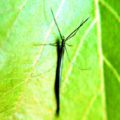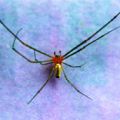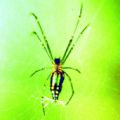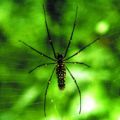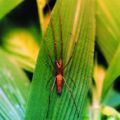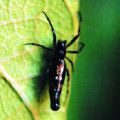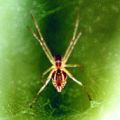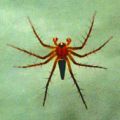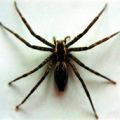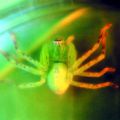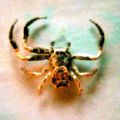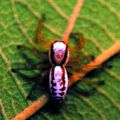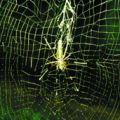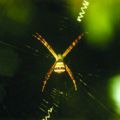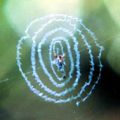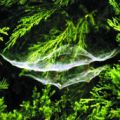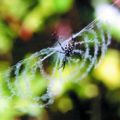Spider
Spider (makdsa) any of the members of the order Araneae, class Arachnida having four pairs of legs, and body consisting of a cephalothorax or prosoma, and an unsegmented abdomen or opisthosoma, attached by a narrow stalk called pedicel. The cephalothorax is covered by a shield or carapace, and bears eight or fewer simple eyes. Antennae absent and the sensory functions are in part performed by the walking legs. On the underside of the head (the cephalic part of the cephalothorax) are two pairs of appendages. The anterior pair called chelicerae, is a two-segmented appendage. The apical segment of chelicerae is fang-like and is connected to a venom gland, with which the spider captures and paralyzes its prey, injecting into it venom produced in the poison glands. The spider then liquefies the tissues of the prey with a digestive fluid and sucks this broth into its stomach. The second pair of appendage is known as the pedipalp. In male, it is modified to function as copulatory organ.
Table Number of genera and species of spiders under different families recorded in Bangladesh.
| Family | No. of genera | No. of species | Habit and habitats |
| Theraphosidae | 1 | 1 | Nocturnal; hides in silk nest among logs and leaf litters in forests. |
| Scytodidae | 1 | 3 | Nocturnal wanderer; remain hidden in the nest of twisted leaves during daytime; live in foliage of forests, gardens, rice fields. |
| Pholcidae | 2 | 3 | Spiders are found in webs underneath foliage, in shaded or dark places of the corners of houses. |
| Oonopidae | 1 | 1 | Live under stone, on the ground or under the bark of trees; leaf mold or debris; some members live in grasses, bushes, and in foliage of different vegetations. |
| Hersiliidae | 1 | 5 | Live on tree trunks, old walls, and spin a scanty web of irregular threads. |
| Uloboridae | 3 | 7 | Commonly found in crop fields, bushes, orchards, forests, etc. |
| Theridiidae | 13 | 36 | Occur in a variety of ecological habitats. Some theridiids are kleptoparasitic in habit, usually occur in the webs of other spiders. |
| Linyphiidae | 7 | 11 | Found to live in the forests or low vegetations or in rice fields, grasses, etc. |
| Tetragnathidae | 8 | 35 | Inhabitants of different vegetations; found in the surroundings of streams, lakes, ponds, etc. They are one of the good predatory agents of pest insects in agro-ecosystems or any terrestrial habitats. |
| Araneidae | 19 | 90 | Mostly occur in the foliage, either high upon the trees or in shrubs, herbs, crop fields, or grasses, and in houses, buildings, etc. |
| Lycosidae | 5 | 19 | Commonly known as wolf spiders, these are strictly ground-dwellers and occupy almost every type of terrestrial habitats from seashore to the high mountains; nocturnal. The spiders are expert hunters and run around in search of prey or hunt on the ground or in small vegetations on ground, or in the crop fields. |
| Pisauridae | 2 | 2 | These are large active hunting spiders, live in the forests, grasses, etc. |
| Oxyopidae | 1 | 18 | Known as 'lynx spiders'; also active hunters, run over vegetations, flowers; diurnal or mostly active during daytime. |
| Agelenidae | 1 | 1 | Members are wanderers, active hunters in the grasses and low vegetations on ground surface. |
| Clubionidae | 4 | 22 | Nocturnal hunting spiders, live on foliage of plants, or loose barks of trees, or in the litters on ground. |
| Corinnidae | 2 | 3 | The spiders found to live in the logs or litters in forests. |
| Trochanteriidae | 1 | 1 | Are found to live in the rice fields, or forest vegetation. |
| Gnaphosidae | 4 | 6 | Nocturnal hunters; generally found almost everywhere, most of them are strictly ground-dwellers; feed on a variety of insects. |
| Sparassidae | 4 | 11 | Live in the rice fields, grasslands, forests or caves, houses; nocturnal hunters. |
| Philodromidae | 1 | 6 | Live mostly on flowering plants; ambush hunters. |
| Thomisidae | 24 | 48 | Live on varieties of plants, especially on the flowering shrubs and bushes. The spiders also wander on the ground and on plants. The thomisid spiders can show a remarkable degree of camouflage or mimicry. Their colouration and markings often exactly coincide with the background on which they are found; ambush hunters |
| Salticidae | 29 | 83 | They are common on plants, logs, fences, and walls of buildings. Some species are arboreal, and some live in litters and lower vegetation zones on the ground. |
| Total | 134 | 412 |
On the under surface near the tip of the abdomen, there are three pairs of spinnerets, associated with the silk glands. The glands produce protein-containing viscid fluids that hardens on exposure to air to form silk threads, used to make silken cocoons or egg cases, silk-lined tunnels, spinning webs, and wrapping prey. The other light silken strands are spun out for ballooning or floating, especially by young spiders.
Some common spiders
-
Argyrodes flagellum
-
Leucauge decorata (Male)
-
Leucauge decorata (Female)
-
Nephila mmaculata
-
Tetragnatha sp.
-
Cyclosa bifida
-
Cyrtpphora cicatrosa
-
Oxyopas shweta
-
Oxyopas sp.
-
Pisaurid spider
-
Olios gravelyi
-
Phrynarachne katoi
-
Asemonea andamanensis
-
Salticid spider
-
Salticid spider
About 37,296 species of spiders are so far known, distributed under more than 3,450 genera, and 106 families. Many new species are being described every year. These arthropods are found everywhere in the world, ranging from tundra to tropical lowland forests, except Antarctica, and usually occur at elevation from sea level to 5,000 m.
They are free-living, commonly solitary, predaceous, feeding mainly on insects and other arthropods; and play a significant role in controlling pest populations of insects, including those that cause human diseases. Some large spiders capture and kill small snakes, birds, and mammals. Hunting spiders (jumping, wolf, and crab spiders) either wait for or wander in search of food, run it down or jump on it. Other spiders entrap their prey in webs. They suck the body fluid of the victim partially digested by enzymes poured out from the gut. Many species are cannibalistic; the female may eat the male when courtship and mating are completed. With few exceptions, spiders are diurnal, active in daytime.
Spiders constitute a rather primitive group; fossil spider faunas have been found in the Red Sandstone of the Devonian. Many species have been described from the Carboniferous of Europe and America. Scientists believe that the two classes, Insecta and Arachnida, became separated early in the evolution of the arthropods.
Web patterns of some spiders
-
Nephila sp.
-
Agriope pulchella
-
Agriope sp.
-
Cyclosa insulana
-
Space-web of C. cicatrosa
-
Araneid spider
In Bangladesh, more than 412 species of different spiders have been recorded under 134 genera, and 22 families (Table). Araneidae and Salticidae are the most dominant families having 90 and 83 species, respectively. These are followed by Thomisidae (48), Theridiidae (36), Tetragnathidae (35), Clubionidae (22), Lycosidae (19), and Oxyopidae (18).
Spiders range in size from less than 0.5 mm to as large as 10 cm. The tropical tarantulas include the largest species. They have no antennae, however, the pedipalps near the mouths are often confused with antennae. Pedipalps are used to manipulate their prey while feeding. The female's palps are slender.
Breathing is by means of tracheae or air tubes or booklungs, or both, located on the underside of the abdomen. Arachnid booklungs are internal and adapted to a terrestrial habitat. Spiders digest food outside their body. After the prey is captured, they inject digestive enzymes from their intestinal tract onto the body of the victim. The enzymes break down the tissues and, after a while, the spider sucks up the predigested, liquid tissues. By repeating this process, spiders digest and suck up the entire internal tissues of the prey animal.
All spiders have venom glands, although most spiders' venom is not harmful to man, except the one produced by the Black Widow and Brown Recluse spiders. The venom of the black widow spider is neurotoxic, that affects the transmission of nerve impulses. The venom produced by the Brown Recluse is necrotic and it may produce a local swelling and death of tissues around the area where the poison is injected.
The characteristic most often associated with spiders is their ability to spin silk, which they can produce throughout their lifetimes. The most elaborate silks are produced by the orb weavers, which spin the most complex prey-catching webs. All spiders, even immature forms, have silk glands and spinning organs called spinnerets. The spider uses its legs to help pull the silk out of the spinnerets. Spiders use silk for a variety of purposes in addition to building webs. They use silk to wrap their prey, to protect their eggs, and to make nests or line their burrows. Some spiders spin silk threads that radiate out from their burrows or nests.
Sexes are separate in spiders and most of them show elaborate courtship behaviour. The pattern may vary among the different species from simple copulation to complex chemical, visual, or vibratory signals. In certain species the females, which are commonly larger than the males, kill and eat the male after mating. Although this is not usually the case, most males live only long enough to copulate once or twice before they die.
Female usually lay their eggs in a silken egg case. In some cases, the egg case or sac is carried by the female until the eggs hatch. The eggs usually hatch soon after being laid. In temperate habitats, during the fall and just before death, large spiders produce one or two very large egg sacs that may contain several hundred eggs.
Small spiders tend to mature sooner than large spiders and spend a greater proportion of their lives reproductively active. Small spiders may produce several egg sacs, and each sac contains fewer eggs.
Nevertheless, because they reproduce early in life, the populations of small spiders can be just as large as or can grow more rapidly than populations of large spiders. The life spans of spiders are variable. Most spiders probably live from one month to one year. Some tarantulas have been known to live in captivity for as long as 20 years. As a rule, the females live longer.
The principal enemies of spiders are wasps that parasitize them and their eggs. Some wasps provision their nests with spiders upon which the wasp larvae feed; others lay their eggs in spiders' egg sacs. Many spiders guard their egg sacs to protect them from this danger.
Rice-field spider Groups of spiders belonging to different families and genera of the order Araneae prefer to live and feed in the rice field environments. Spiders occur abundantly in both agricultural and natural ecosystems, averaging about 50,000 individuals per acre in vegetated areas.
The spiders are most effective natural enemies of insect pests and constitute the best known biological control agent in all form of agroecosystem. From the rice-fields of South and Southeast Asian countries as many as 342 species of spiders belonging to 131 genera under 26 families have been reported. A study conducted by the former Institute of Postgraduate Studies in Agriculture, Salna (now Bangabandhu Sheikh Mujibur Rahman Agricultural University) and Japan International Cooperation Agency (JICA) during 1989-1990 recorded 55 species of spiders from different rice-fields belonging to 36 genera under 10 families. Species of Oxyopidae were found dominant followed by Tetragnathidae. The best known species Pardosa pseudoannulata commonly familiar as wolf spider, is most effective predator of brown planthopper (BPH), Nilaparvata lugens, a major rice insect pest. The spider keeps the BPH population low under favourable environmental conditions.
Other notable rice-field spider species of Bangladesh are: Coleasoma blandum (Theridiidae), Oedothorax formosanus (Linyphiidae), Araneus inustus (Araneidae), Neoscona theisi (Araneidae), Argiope minuta (Araneidae), Cyclosa mulmeinensis (Araneidae), Tetragnatha javana (Tetragnathidae), and Oxyopes javanus (Oxyopidae). Species of Thomisidae and Salticidae are fairly common in irrigated fields. [Md. Ahsan Habib]

